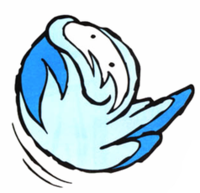Cloud Drop
- Not to be confused with Gusty.
| Cloud Drop | |||
|---|---|---|---|
 Artwork from Super Mario World 2: Yoshi's Island | |||
| First appearance | Super Mario World 2: Yoshi's Island (1995) | ||
| Latest appearance | Yoshi's New Island (2014) | ||
| |||
| |||
Cloud Drops,[1][2] also referred to as Blusties[3] or erroneously Gusties,[4] are enemies in Super Mario World 2: Yoshi's Island (and its reissue), Yoshi Touch & Go, Yoshi's Island DS, and Yoshi's New Island. They are cloud monsters that fly in a short line vertically or horizontally. Cloud Drops are commonly encountered in areas where a Yoshi can turn into a helicopter. Cloud Drops move quickly, but they can be defeated if jumped on. While their Super Mario World 2: Yoshi's Island artwork depicts them as a recolor of the Lava Drop, Cloud Drops have distinct sprites.
In Yoshi's Woolly World, there are enemies resembling Cloud Drops, known as Wiks.
Profiles[edit]
Super Mario World 2: Yoshi's Island / Yoshi's Island: Super Mario Advance 3[edit]
- Shogakukan guide: ゆらゆらと同じ場所を行ったり来たり。タマゴ投げで倒したり、食べたりもできる。[5] (It wobbles back and forth in the same place. You can throw an egg to defeat or eat it.)
- Player's Guide: Watch out for these wherever the billowy white stuff is found on Yoshi's Island.[1]
- Shogakukan guide (Game Boy Advance version): ゆらゆらと同じ場所を行ったり来たり。食べてしまうか、タマゴ投げで倒そう。[6] (It wobbles back and forth in the same place. Eat it or defeat it by throwing an egg.)
Yoshi Touch & Go[edit]
- Shogakukan guide: 空中の同じルートを、上下または左右に往復する。ルートをさえぎるように雲を描き、足止めしてから倒すといい。たくさんいるときは、雲で壁を作って、反対側に閉じこめてしまえば安全。[7] (It will move back and forth along the same route in the air, either up and down or to the left and right. It is a good idea to draw a cloud to block the route, stop them in their tracks, and then take them down. If there are many of them, it is safer to build a wall with clouds and confine them on the other side.)
Yoshi's New Island[edit]
- Shogakukan guide: 一定の区間を、上下あるいは左右に往復移動する。移動速度は速めだ。とはいえ、移動区間をチェックしておけば、簡単に避けたり攻擊したりできる。[8] (The character moves back and forth in a fixed section, either up and down or left and right. The speed of movement is fast. However, it is easy to avoid or attack if you pay attention to its travel path.)
Gallery[edit]
Artwork[edit]
Yoshi's Island line drawing by Masanori Sato
Sprites[edit]
Names in other languages[edit]
The contemporaneous name for each language is listed first. Subsequent names are listed in chronological order for each language, from oldest to newest, and have the media they are associated with in the "notes" column.
| Language | Name | Meaning | Notes |
|---|---|---|---|
| Japanese | おたま[5][6][7][8] Otama |
From「蝌蚪」(otamajakushi, "tadpole" or "music note") | |
| French | Blusty[9] | - | |
| German | Orkanino[10] | Diminutive of Orkan ("hurricane") | |
| Luft-Polterer[11] | From Luft ("air") and "poltergeist" | Super Mario World 2: Yoshi's Island | |
| Italian | Fantondo[12] | Portmanteau of fantasma ("ghost") and tondo ("round") | |
| Portuguese | Blusty[13] | - | |
| Spanish | Flotasma[14] | Portmanteau of flotar ("to float") and fantasma ("ghost") |
References[edit]
- ^ a b Miller, Kent, and Terry Munson (1995). Super Mario World 2: Yoshi's Island Player's Guide. Nintendo of America (American English). Page 126.
- ^ Williams, Drew (November 6, 2006). Yoshi's Island DS Player's Guide. Nintendo of America (American English). ISBN 1-59812-016-6. Page 91.
- ^ 2005. Yoshi Touch & Go European instruction booklet. Nintendo of Europe (British English). Page 26.
- ^ 2005. Yoshi Touch & Go Australian instruction booklet. Nintendo of Australia (Australian English). Page 25.
- ^ a b Okeya, Noriko, Mitsuharu Orihara, and Yuji Kigen, editors (1995). 『スーパーマリオヨッシーアイランド任天堂公式ガイドブック』. Tokyo: Shogakukan (Japanese). ISBN 4-09-1025-234. Page 5.
- ^ a b Watanabe, Takashi, Noriko Oketani, Mitsuharu Orihara, Tatsuhiko Mizutani, and Yasushi Nakahara, editors (2002). 『スーパーマリオアドバンス3任天堂公式ガイドブック』. Tokyo: Shogakukan (Japanese). ISBN 4-09-106071-4. Page 14.
- ^ a b March 22, 2005. 「キャッチ!タッチ!ヨッシー!任天堂公式ガイドブック」 (Catch! Touch! Yoshi! Nintendo Kōshiki Guidebook). Shogakukan (Japanese). ISBN 4-09-106218-0. Page 12.
- ^ a b Iwaya, Kiyotaka, Tatsuhiko Mizutani, Yasuyuki Kato, Junko Fukuda, Kunio Takayama, and Yasushi Nakahara (Shogakukan), editors (2014). 『ヨッシー New アイランド 任天堂公式ガイドブック』. Tokyo: Shogakukan (Japanese). ISBN 978-4-09-106542-1. Page 18.
- ^ 2005. Yoshi Touch & Go mode d'emploi (PDF). Großostheim: Nintendo of Europe GmbH (French). Page 86.
- ^ 2005. Yoshi Touch & Go Spielanleitung (PDF). Großostheim: Nintendo of Europe GmbH (German). Page 56.
- ^ Menold, Marcus, John D. Kraft, and Thomas Görg, editors (1995). Der offizielle Nintendo Spieleberater "Super Mario World 2 – Yoshi's Island". Großostheim: Nintendo of Europe GmbH (German). Page 18.
- ^ 2005. Yoshi Touch & Go Manuale di Istruzioni (PDF). Großostheim: Nintendo of Europe GmbH (Italian). Page 86.
- ^ 2005. Yoshi Touch & Go Manual de Instruções. Großostheim: Nintendo of Europe GmbH (European Portuguese). Page 56.
- ^ 2005. Yoshi Touch & Go Manual de Instrucciones (PDF). Großostheim: Nintendo of Europe GmbH (European Spanish). Page 26.
| Yoshi Touch & Go | |
|---|---|
| Characters | Baby Luigi • Baby Mario • Kamek • Stork • Yoshis |
| Items | Blue Coin • Bubble • Fruit (Apple · Banana · Grape · Melon · Watermelon) • Red Coin • Yellow Coin • Yoshi's Egg |
| Enemies and obstacles | Brier • Bumper • Cheep Cheep • Cloud Drop • Fang • Fly Guy • Goonie • Gusty • Kamek's Toadies • Lakitu • Marutchi • Monty Mole • Needle • Piranha Plant • Propeller Mūcho • Shy Guy • Spiny Cheep-Cheep • Tap-Tap • Toady • Ukiki • Whirly Fly Guy • Wild Ptooie Piranha |
| Other | Gallery • Multimedia • Staff |







